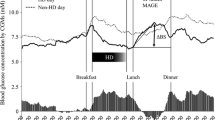Abstract
As the concentration of total glycosylated hemoglobin (Hb AI) may be responsive to acute fluctuations in blood glucose, and as Hb AIc is known to have increased in vitro oxygen affinity, we evaluated whether acute variations in Hb AI were accompanied by changes in hemoglobin-oxygen affinity in insulin-dependent diabetic children.
Blood glucose, Hb AI, hemoglobin-oxygen affinity and related parameters were determined in 42 diabetic children in the fasting state before insulin and 6 h later following their usual insulin dose and meals. During the 6-h period significant increases occurred in the mean concentrations of blood glucose and Hb AI (P<0.001), and a correlation was present between the increment in blood glucose and that in Hb AI (r=0.62, P<0.001). The mean hemoglobin-oxygen affinity also increased, but this change was found to be unrelated to the increase in Hb AI. The increment in hemoglobin-oxygen affinity correlated with an increment in blood pH (r=0.49, P<0.001). Hemoglobin concentration, hematocrit, and red cell 2,3-DPG content were significantly elevated in the diabetic children compared to 30 healthy children (P<0.005), and in the diabetic children the Hb AI correlated with hemoglobin, hematocrit and erythrocyte count (P<0.05).
The present study indicates that in juvenile diabetics rapid fluctuations may occur in Hb AI which are glucose-dependent, whereas the simultaneous minor change in hemoglobin-oxygen affinity appears to be pH-dependent.
Similar content being viewed by others
References
Trivelli LA, Ranney HM, Lai HJ (1971) Hemoglobin components in patients with diabetes mellitus. N Engl J Med 284:353
Koenig RJ, Peterson CM, Jones RL, Saudek C, Lejrman M, Cerami A (1976) Correlation of glucose regulation and hemoglobin AIc in diabetes mellitus. N Engl J Med 295:417
Paulsen EP, Koury M (1976) Hemoglobin AIc levels in insulin-dependent and independent diabetes mellitus. Diabetes 25 [Suppl 2]:890
Gabbay KH, Hasty K, Breslow JL, Ellison RC, Bunn HF, Gallop PM (1977) Glycosylated hemoglobins and long-term blood glucose control in diabetes mellitus. J Clin Endocrinol 44:859
Gonen B, Rubenstein AH, Rochman H, Tanega SP, Horwitz DL (1977) Haemoglobin AI: An indicator of the metabolic control of diabetic patients. Lancet II:734
Lanoe R, Soria J, Thibault W, Soria C, Eschwege E, Tchobroutsky G (1977) Glycosylated haemoglobin concentrations and clinitest results in insulin-dependent diabetes. Lancet II:1156
Ditzel J, Kjærgaard JJ (1978) Hemoglobin AIc in newly discovered diabetics before and after insulin. Br Med J I:741
Dunn PJ, Cole RA, Soeldner JS, Gleason RE, Kwa E, Fircozabade H, Younger D, Graham CA (1979) Temporal relationship of glycosylated hemoglobin concentrations to glucose control in diabetes. Diabetologia 17:213
Bolli G, Cartechini MG, Compagnucci P, Santeusanio F, Massi-Benedetti M, Calabrese G, Puxeddu A, Brunetti P (1980) Modification of glycosylated haemoglobin concentration during artificial endocrine pancreas treatment of diabetics. Diabetologia 18:125
Svendsen PA, Christiansen JS, Søegaard U, Welinder BS, Nerup J (1980) Rapid changes in chromatographically determined haemoglobin AIc induced by short-term changes in glucose concentration. Diabetologia 19:130
Bunn HF, Briehl RW (1970) The interaction of 2,3-diphosphoglycerate with various human hemoglobins. J Clin Invest 49:1088
Ericsson AA, Verdier CH de (1972) A modified method for the determination of 2,3-diphosphoglycerate in erythrocytes. Scand J Clin Lab Invest 29:85
Duvelleroy MA, Buckles RG, Rosenkalmer S, Tung C, Laver MB (1970) An oxyhemoglobin dissociation analyzer. J Appl Physiol 28:227
Arturson G, Garby L, Robert M, Zaar B (1974) The oxygen dissociation curve of normal human blood with special reference to the influence of physiological effector ligands. Scand J Clin Lab Invest 34:9
Bunn HF, Haney DN, Gabbay KH, Gallop PM (1975) Further identification of the nature and linkage of the carbohydrate in hemoglobin AIc. Biochem Biophys Res Commun 67:103
Ditzel J, Jaeger P, Standl E (1978) An adverse effect of insulin on the oxygen release capacity of red blood cells in non-acidotic diabetics. Metabolism 27:927
Ditzel J (1979) Changes in red cell oxygen release capacity in diabetes mellitus. Fed Proc 38:2484
Graham JJ, Ryall RG, Wise PH (1980) Glycosylated haemoglobin and relative polycythaemia in diabetes mellitus. Diabetologia 18:205
Ditzel J (1980) Affinity hypoxia as a pathogenetic factor of microangiopathy with particular reference to diabetic retinopathy. Acta Endocrinol 94 [Suppl 238]:39
Author information
Authors and Affiliations
Rights and permissions
About this article
Cite this article
Ditzel, J., Kawahara, R., Mourits-Andersen, T. et al. Changes in blood glucose, glycosylated hemoglobin and hemoglobin-oxygen affinity following meals in diabetic children. Eur J Pediatr 137, 171–174 (1981). https://doi.org/10.1007/BF00441311
Received:
Issue Date:
DOI: https://doi.org/10.1007/BF00441311




